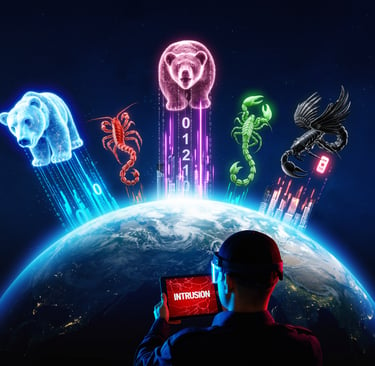Global Cyberwarfare Alert: How Russian, Chinese, Iranian & North-Korean Hackers Are Shaking the Planet in 2025
From telecom giants to court systems, 2025 has become the year of state-backed cyber chaos as Russian, Chinese, Iranian and North-Korean hacking groups scale up operations worldwide.
CYBERSECURITY


The Global Tremor: How Russian, Chinese, Iranian & North-Korean Hackers Are Escalating Cyberwarfare in 2025
Introduction – A Planet Under Siege
Cyber-attacks are no longer isolated incidents; they are continuous, coordinated campaigns. In 2025, APT groups tied to Russia, China, Iran and North Korea account for over 60 % of all nation-state activity recorded by threat-intel firms. Their operations span espionage, sabotage, financial theft and disinformation, causing record-breaking breach costs averaging USD 10 million per incident in the United States—double the global mean.
1. Russia: Wipers, Impersonation & Supply-Chain Sabotage
Russian APTs such as Gamaredon, Sandworm, RomCom and InedibleOchotense have intensified attacks on Ukraine and NATO-aligned states, contributing ≈ 40 % of worldwide APT incidents between April and September 2025 .
Destructive malware: Sandworm deployed ZEROLOT and Sting wipers against Ukrainian energy, logistics and grain sectors, aiming to cripple wartime supply lines.
Zero-day exploitation: RomCom weaponized a WinRAR zero-day to compromise European & Canadian manufacturing, finance and defense firms.
Brand abuse: InedibleOchotense impersonated cybersecurity company ESET in phishing emails that delivered the Kalambur backdoor, showing how Russian groups undermine trust in security vendors themselves.
Cross-group synergy: Gamaredon reused Turla’s backdoor on high-value targets, hinting at selective operational cooperation among Moscow-aligned units.
2. China: Telecom Take-Over & Government Infiltration
Chinese activity surged after Salt Typhoon—one of the largest telecom breaches ever—infiltrated nine major carriers, accessing law-enforcement wiretap systems and presidential-candidate phones across 80 countries.
Persistence in utilities: PRC actors maintained months-long access inside a public power grid network in Littleton, MA, exposing U.S. critical-infrastructure fragility.
SharePoint tsunami: Storm-2603, Linen Typhoon and Violet Typhoon hijacked Microsoft SharePoint to breach 400+ organizations, including U.S. Department of Energy, DHS and HHS, exfiltrating policy and R&D data.
AI enhancement: Beijing-directed groups increasingly prompt-engineer generative-AI models for spear-phishing lures and vulnerability research, shortening attack development cycles.
3. Iran: Internal Spear-Phishing & Regional Disruption
Iran-linked incidents jumped 133 % during May–June 2025 amid geopolitical tensions, with MuddyWater (APT37) pioneering "internal spear-phishing": hijacking a corporate mailbox to phish colleagues, bypassing perimeter defenses.
Victim spread: Nigerian maritime, Greek telecom, Israeli high-tech and U.S. municipal governments all reported MuddyWater intrusions.
PowerShell dominance: GalaxyGato refined file-less scripts to harvest credentials in Israel & Greece, leaving minimal forensics.
Court system breach: A Russia-Iran hybrid operation hit the U.S. federal courts’ e-filing portal, compromising sensitive case metadata.
4. North Korea: Crypto-Heists & macOS Expansion
Pyongyang’s Lazarus, Kimsuky, Konni and DeceptiveDevelopment conduct ≈ 14 % of global APT activity, mixing espionage for the regime with bank-theft for its treasury.
Fake-jobs supply-chain: DeceptiveDevelopment lured crypto developers with trojanized GitHub repositories, stealing private keys and smart-contract source code.
Zero-day in installers: Lazarus corrupted legitimate South Korean software installers, leading to undetected backdoors inside gaming and fintech firms.
First macOS campaign: Konni released an EggShell backdoor variant targeting Apple executives in Uzbekistan, marking expansion beyond Windows.
AI-enhanced IT infiltration: One in six 2025 breaches involved AI-generated résumés by North Korean freelancers who secured remote U.S. tech jobs, funneling proprietary code home.
5. Escalation Drivers – Why 2025 Is Different
AI democratization: Generative AI lowers language-barriers and coding gaps, letting Tier-2 actors produce Tier-1 malware.
Geopolitical flashpoints: Ukraine war, Taiwan Strait tensions, Israel–Iran conflict translate into digital retaliation cycles.
Commoditized zero-days: Dark-web marketplaces sell browser & telecom exploits for < USD 500 k, affordable even for sanction-strapped states.
Hybrid cooperation: Russian & Iranian cells occasionally swap tools; Chinese subcontractors rent North Korean crypto-laundering pipelines, complicating attribution.
6. Fallout – Counting the Cost
44 U.S. states declared cyber incidents in 2025; St. Paul, MN and Mission, TX issued states of emergency after ransomware paralyzed 911 systems.
Double-extortion ransomware hits European hospitals, delaying chemotherapy appointments and undermining public trust.
Market volatility: A single Lazarus crypto-exchange heist moved USD 600 million in Ethereum, spooking DeFi token prices for weeks.
7. Defense Playbook – 7 Steps to Resilience
Zero-Trust segmentation inside OT/IT networks; Russian wipers thrive on flat architecture.
AI-resistant email gateways that analyze conversation context, not just malicious links, to defeat MuddyWater’s internal phishing.
SharePoint hardening: disable anonymous scripting, enforce PIM approval for site-collection admins, patch within 24 h; Chinese groups feast on legacy team sites.
Vendor-side code-signing verification; North Korean supply-chain attacks insert backdoors into signed binaries—check certificate transparency logs.
Deception grids: deploy fake crypto-wallets and dummy Jenkins servers; Lazarus operators waste time & reveal TTPs on decoys.
Geo-fraud monitoring for remote hiring: validate government ID + live video + impossible-travel analytics to spot North Korean IT moles.
Collective intel sharing: join ISACs & CISA’s JCDC; Salt Typhoon was partially uncovered via cross-carrier telemetry correlation.
Conclusion – The Red Lines Are Blurred
Cyber escalation by Russian, Chinese, Iranian and North-Korean hackers is reshaping global power dynamics. Destruction is now collateral to data theft, espionage blends with disinformation, and AI multiplies attacker speed. Organizations that fuse threat-intel, zero-trust and collective defense will weather the tremor—those that don’t may find themselves the next headline.
Sources
Industrial Cyber, US Homeland Security Committee warns of rising cyber-threats, 03 Nov 2025.
Help Net Security, Global APT Activity Report 2025, 06 Nov 2025.
Trolleye Security, Top 10 State-Sponsored Threat Actors, 27 Feb 2025.


